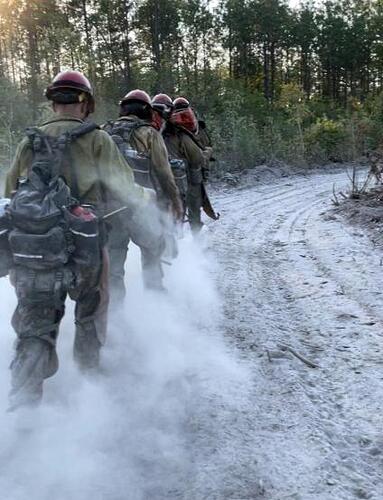Southern Area a Top Priority for National Wildfire Response
The last time the Southern Area was the top priority nationally was 18 years ago during Hurricane Katrina.
Sheila Holifield
Southern Region Office of Communication
September 13, 2023
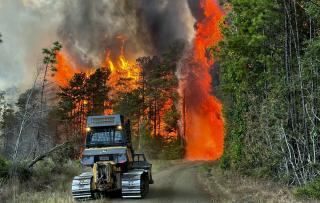
On August 24, Forest Service crews assisted Texas A&M Forest Service by putting in containment lines to help slow the Shearwood Creek Fire’s spread in Jasper, Texas. (USDA Forest Service photo by Danny Harris)
The South is burning. Over 15,700 wildfires have burned 505,179 acres since New Year’s Day 2023. Persistent dry conditions and high temperatures have created the right circumstances for extreme fire behavior at an unexpected time of year.
“The weather we are seeing is unprecedented. In the western part of the South, we have extremely high temperatures and drought, and to the east we are monitoring hurricanes,” said Ken Arney, regional forester for the U.S. Department of Agriculture’s Forest Service, Southern Region.
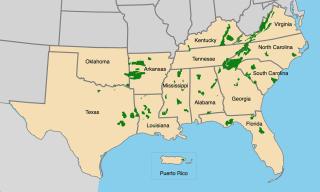
The Forest Service’s Southern Region includes 14 national forests and grasslands in 13 states and Puerto Rico. The Southern Area is currently the top priority geographic area for wildfires nationally, according to the National Incident Management Situation Report. (USDA Forest Service graphic)
According to the National Incident Management Situation Report — a synopsis of wildland fire activity across the country — the Southern Area remains the top priority for firefighting resource assignments nationally. During this time of year, it is the West that usually has the most critical fire activity. The last time the Southern Area was the highest priority area in late summer for incident response was after Hurricane Katrina in 2005.
As a changing climate continues to create unusual weather patterns, the Forest Service is urging citizens to take steps to prevent wildfires at home and while recreating in national forests. Accumulating fuels and expanding urban development in fire-prone landscapes adjacent to national forests is a concern.
The Smokey Bear Hotshots from the Lincoln National Forest in Alamogordo, New Mexico respond to the Tiger Island Fire in Louisiana. (Photo courtesy of JJ Rue)
“Wildfire management and reducing wildfire risk is challenging and complex due to rapid population growth, rapid expansion of wildland-urban interface, and the fragmentation of land ownership in the Southern Region,” said Arney.
Since 1990, the wildland urban interface in the South has grown by more than 24.7 million acres, making it one of the fastest growing regions in the nation. Today, more people than ever are living with heightened wildfire risk because their homes intermingle with forests and nature, where wildfire risk is higher. Many forests in the South are within a mile of residential areas and more than 90 million acres are classified as wildland-urban interface.
“Because fires don’t stop at property boundaries, the Forest Service is committed to coordinating with our federal, state and local partners to protect life, property and natural resources from the threat of wildfire, and develop resilient forests and communities,” said Arney.
About 86% of the 212 million acres of forestland in the South is privately owned. Just like landowners are responsible for managing their lands, homeowners and communities have a responsibility to manage their property and infrastructure in ways that are compatible with the fire-dependent ecosystems that surround them.
“The public plays a valuable role in wildfire prevention,” said Shardul Raval, director of Fire and Aviation Management for the Forest Service, Southern Region. “We must do all we can to develop fire-adapted communities and recreate outdoors responsibly.”
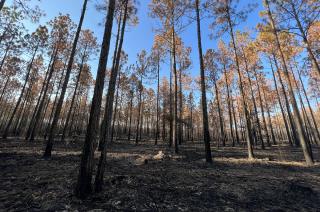
As the Tiger Island Fire near Merryville, Louisiana moved through the forests, it burned many pine trees. Now, these areas are at risk for “needle cast,” which happens when dead pine needles fall to the ground and cause some reburning. Crews work to clean out these pine needles so they don’t become fuel for new fires that could threaten fire lines. (USDA Forest Service photo)
Dry and windy weather conditions often contribute to a wildfire’s intensity, and it can grow quickly in a matter of days, added Raval.
“Our firefighters are incredibly proficient in emergency response and coordinate closely with partners and landowners to reduce wildfire risk. Firefighter and public safety are always the highest priority during a wildfire,” said Raval.
The Forest Service develops, supports and promotes fire adapted communities because of the number of homes near forested lands.
“Fire-adapted doesn’t mean fireproof. But these communities are prepared for, and adapted to, living with fire,” said Raval.
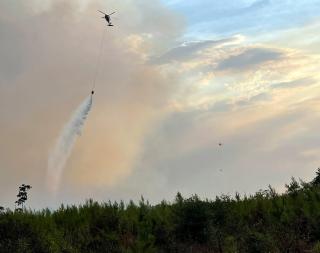
A helicopter drops water to slow the spread of the Shearwood Creek Fire in Jasper, Texas. (USDA Forest Service photo by Kye Kartye)
To prepare for wildfires, the Forest Service encourages proactive actions to mitigate risks before a fire starts. Find out if your home is at risk at https://www.southernwildfirerisk.com. Find out more information about helping your community plan and prepare for wildfires at Wildfire Risk to Communities | US Forest Service.
Editor’s Note: The National Cohesive Wildland Fire Management Strategy identifies that the Southern Region’s joint fuels reduction program efforts directly or indirectly protect more than 58,000 communities and 89 million acres in areas where communities are intermingled with forest lands, also known as wildland urban interface.
Firewise: Although wildfires will continue to happen, you can take action now to protect your home, neighborhood and family’s safety. The Firewise USA® program can help you get started. NFPA - Firewise USA®
Community Wildfire Defense Grants: The Forest Service is accepting applications for the Community Wildfire Defense Grant program. Now in its second year, this competitive program funded by President Biden’s historic Bipartisan Infrastructure Law is designed to assist at-risk communities, including tribal communities, non-profit organizations, state forestry agencies and Alaska Native Corporations with planning for and mitigating wildfire risks. Applications will be accepted until 11:59 p.m. eastern time on October 31, 2023.
